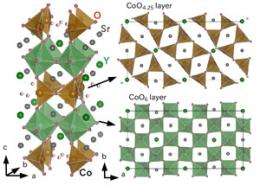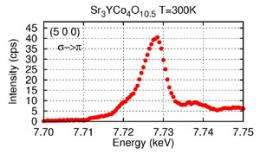Long-time mystery in cobalt oxides

The existence of an intermediate-spin (IS) state in cobalt oxides has long been a subject of dispute. A recent resonant X-ray scattering experiment has clearly demonstrated Co3+ eg orbital ordering in Sr3YCo4O10.5, which has the highest ferromagnetic transition temperature among perovskite-type cobalt oxides. This result provides not only a clue to understanding the magnetism but also the first clear evidence of the existence of an IS state in Co3+. This discovery is expected to open a new field of materials physics, which will combine the IS state concept with many interesting magnetic and electric properties.
Strongly correlated electron systems show various intriguing physical properties due to the close interplay among the charge, spin, and orbital degrees of freedom. In cobalt oxides, spin-state degrees of freedom such as low-spin (LS), high-spin (HS), and the IS state additionally emerge, and a wide variety of physical properties associated with the spin-state are expected. Especially, the existence of IS state is a highly controversial problem. Because the IS state never becomes the ground state in the ligand-field theory, while signs of the existence of the IS state were reported experimentally. To date, there was no clear experimental evidence of the existence of the IS state.
Sr4-xRxCo4O10.5 (R = Y and lanthanide, 0.8 < x < 1.0) was recently discovered as a room temperature ferromagnet with TC ~ 370 K, which is the highest TC among perovskite-type cobalt oxides. This material has a typical crystal structure shown in Fig. 1: The Sr and Y ions are ordered, and the CoO6 octahedral layers and oxygen vacant CoO4.25 layers are alternately stacked in the direction of the c-axis, while an ideal perovskite structure is composed of a three-dimensional framework of corner-sharing CoO6 octahedron. As an origin of the ferromagnetism, an importance of spin-state degrees of freedom of Co3+ (3d6), namely HS (t2g4eg2), LS (t2g6), and IS (t2g5eg1), was proposed on the basis of recent powder X-ray diffraction experiment. Therefore it is important to study not only the existence of IS state of Co3+ but also the eg orbital ordering of the IS state.

A research group led by Associate Professor Hironori Nakao at the Institute of Materials Structure Science, KEK, conducted resonant X-ray scattering experiments using BL-3A and BL-4C, synchrotron radiation research facilities (Photon Factory) at KEK. The resonance X-ray scattering technique is widely used to examine charge, orbital and spin structures. By using X-ray energy near the absorption edge*5 of each element, this technique allows us to determine the charge, orbital, and spin-ordered states of each element.
To clarify the orbital ordering in the ferromagnetic phase, the energy dependence of the scattering intensity has been measured at several reciprocal lattice points. The signals resonating near Co K-edge energy were found at (h00): h=4n+-1 reflection. The energy dependence of scattering intensity at (500): h=5 is shown in Fig. 2. Moreover, the RXS signals show a large h dependence of the scattering intensity. The polarization and azimuthal angle dependence of the RXS signal was also measured at 7.727 keV corresponding to the 1s → 4p transition energy. These results clearly indicate the existence of the anisotropic Co-site ordering as shown in Fig. 3. However, it was difficult to distinguish between the eg and t2g orbital ordering of Co3+, since the signal has the information of Co 4p state.
In order to clarify the existence of the eg orbital ordering of the IS state, they noted the RXS signal at the pre-edge region (1s → 3d transition energy). There the RXS signal at 1s → eg transition energy, which is stronger than that at 1s → t2g transition energy, was discovered. This is direct evidence of not only eg orbital ordering but also the presence of the IS state. The signal at the 1s → eg transition energy reflects the anisotropy of the eg orbital, and only the IS state of Co3+ ion has the eg orbital degrees of freedom. They also proposed a peculiar spin-state ordering (HS/IS states) and a ferrimagnetic structure based on the determined orbital structure (Fig. 3). These results appear in the February 2011 issue of the Journal of the Physical Society of Japan (JPSJ), an English journal published by the Physical Society of Japan. It was selected as one of the Papers of Editors' Choice, which are noteworthy papers commended by the editorial committee.
These results reveal that the spin state degree of freedom plays an important role in producing a ferromagnetic phase. This are expected to open a new field of materials physics dealing with spin state degree of freedom.
Provided by Lightsources.org


















